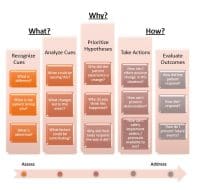As we emerge from the COVID-19 pandemic, the damage it has left in its path will take years to clean up. Just like with any other catastrophic disaster, the aftermath of the pandemic’s long-term health effects, both physical and psychological, will be around for years to contend with.
For a nurse and patient experience professional, the sequelae of a pandemic aren’t just absolved; the effects on the public and society at large continue to linger and manifest. We see this through increased verbal abuse and physical violence toward healthcare workers as well as an increase in mistrust of healthcare providers among patients and their families.
Across the nation, scores on patient experience surveys have significantly declined since the pandemic. With so many variables—such as longer wait times, delayed care, workforce shortages, and increased healthcare costs—contributing to the root causes of declining patient experience scores, where does one begin to embark on healthcare experience improvement efforts?
A strategic approach that has been fundamental throughout my nursing career and is the cornerstone of my nursing practice includes making genuine connections with my patients and their families. As a nurse, entering the life of a virtual stranger while they may be in the midst of the most challenging moment in their life is a privilege never to be taken lightly.
Relational work is central to healthcare. In what other profession do you express your most personal and private health information and entrust your life?
Some may argue relational work is too time consuming when faced with the increase in demand for healthcare services and stretched resources; however, if incorporated into your existing practice, establishing a rapport and getting to know the patient will improve their experience and help ensure that we deliver high-quality, safe, and patient-centered care.
When I assumed a new organizational leadership role after the pandemic, devising a hospital-wide Patient and Family Advisory Council was imperative. It’s had a positive impact on patient experience, staff satisfaction, and health outcomes. Patient and Family Advisory Councils bring together patients, families, and staff to work on initiatives, program development, and policies. Fostering relationships between the organization and those we serve through our partnership of co-designing care demonstrates that we value the voices of our patients’. It’s one of many methods we can employ to rebuild our relationship with our patient’s, their families and the communities we serve as we contend with the consequences from the pandemic.
Nicole Kirchhoffer is assistant vice president and patient experience officer at Maimonides Health in New York, New York.
Reference
Clay AM, Parsh B. Patient- and family-centered care: It’s not just for pediatrics anymore. AMA J Ethics. 2016;18(1):40-44. doi:10.1001/journalofethics.2016.18.1.medu3-1601 journalofethics.ama-assn.org/article/patient-and-family-centered-care-its-not-just-pediatrics-anymore/2016-01


















